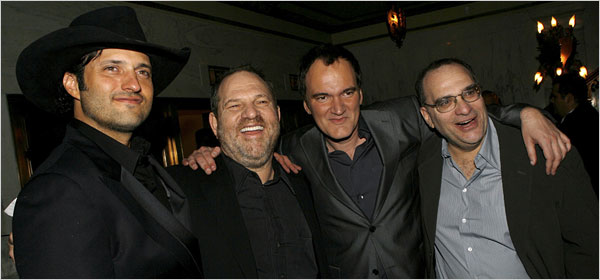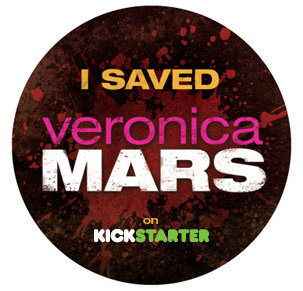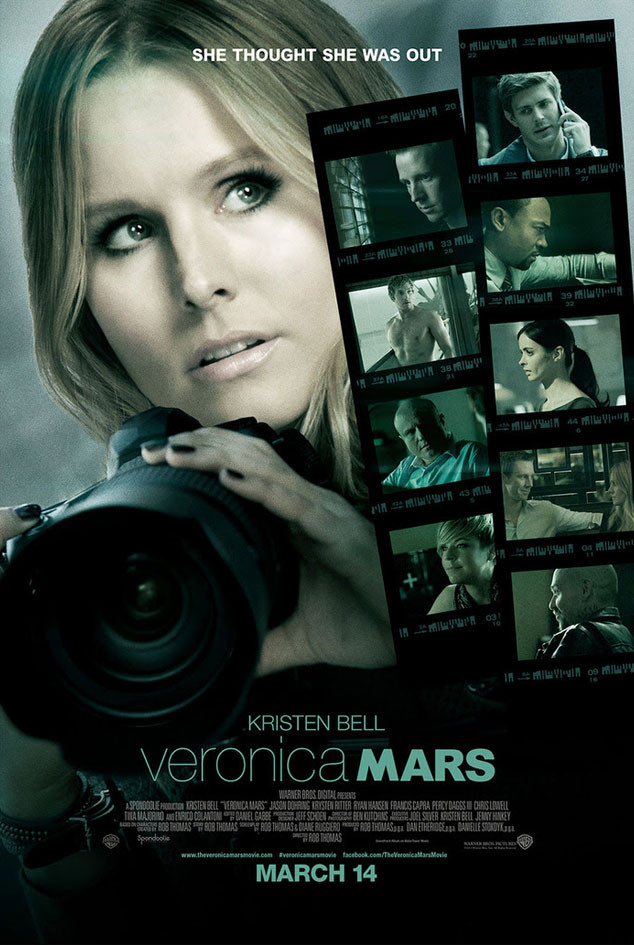
Movies like Veronica Mars are good news for movie fans everywhere – even if teenage-detective film noir isn’t your cup of tea and even if Veronica Mars doesn’t make a lot of money. Why is this such good news?
Because the movies are broken, and maybe Veronica Mars can give film makers ideas about how to fix them.
Were the *gasp* 1990’s the Golden Age of Cinema?
In case you haven’t noticed, the number of high-quality movies – for those who aren’t fans of the comic-book or video-game derivatives – has decreased dramatically. Even the grande dame of movies herself, Meryl Streep, has complained about the decline of movies on 60 Minutes.
The subject matter of movies has changed a lot in the last twenty years. The movies released in 1996, for example, seemed to be a more balanced assortment. Sure, there were action movies like Independence Day and horror flicks like Scream. But, 1996’s movies also included sweeping epics like The English Patient, courtroom dramas like The People vs. Larry Flynt, thrillers like Fargo, and even feel good comedy-dramas like Jerry Maguire.
Admittedly, my coming of age in the heyday of the now-dead Miramax Studios may have spoiled me for today’s mediocre fare. Perhaps, I unwittingly internalized movies like My Left Foot, Shakespeare in Love, The Crying Game, The Talented Mr. Ripley, Pulp Fiction, and Sex, Lies and Videotape as the standard.

Still, today’s movies seem to be disproportionately skewed towards horror, big-budget action/sci-fi, and comic-book franchises. These genres are all beloved by the teenage boy (technically, the 14-24 year old male demographic) – the darling of the studios since they attend movies more than anyone else.
Understandably, given the enormous risk involved in gambling $100 million on the public’s taste, studio executives gravitate towards safe bets and solid return on investment (ROI). The focus on ROI and dollars earned drives which movies get made.
In a Forbes article last summer, the magazine noted, “Horror films are definitely Hollywood’s best bet in terms of turning a profit.” In fact, according to New York Times, excluding documentaries, horror films are the most profitable genre by far. Horror movies can be cheap to make – so they are low risk – and have the potential for huge profits. The Purge cost a paltry $3 million to make – peanuts by Hollywood standards – and grossed $80 million globally. That’s a whopping 2600% return on investment. Between 2003 to 2009, on average, horror movies global box office receipts returned a hefty 12x their production budget!

For studios, horror is great. But to make the mega bucks they need, they have to make the big-budget franchise blockbusters, like the Iron Mans, Spider-Mans, and Pirates of the Caribbeans to name a few. Studios see the blockbusters as a bit of insurance – a tent-pole strategy that will keep the studio afloat and balance out its financial performance if other movies flop. Plus comic-book movies and movies like the quite enjoyable Harry Potter franchise offer something epics and romantic comedies don’t: revenue streams from licensing for action figures, games, merchandise, etc.
When the production budget of the average movie today is $130 million, it’s understandable that studios want to make safe choices for such big-budget pictures. But, what’s surprising is that studios don’t want to make movies with small budgets. Studio execs perceive small budget films as riskier; they often have a lower return on investment for every dollar spent. Before 2000, few movies had budgets over the once staggering $100 million mark. But, then studios began to realize that it can take ten or twenty small budget films to equal the profits from one big budget blockbuster – and they were more apt to have a hit with the $100 million picture.
Worse, today any movie can cost a fortune – on average $35.9 million — to market. In fact, George Lucas lamented the high cost of marketing movies coupled with the drive to make movies for the masses as a factor in why it is so hard to get niche films made.
Dramas – especially historical dramas – with their huge production budgets, older demographic, and lower potential for profits, are almost dead as a movie genre. These are pretty much TV only. Even Oscar-nominated Lincoln was a hair’s breadth away from being an HBO movie. And, Steven Spielberg himself with his platinum box office record, noted at University of Southern California last year that he had to co-own his own movie studio to get Lincoln into theaters. Spielberg and George Lucas observed that, as Lucas put it, “the Lincolns will go away and they’re going to be on television.”
Ironically, these big budget films may have the exact opposite of their intended effect: they could destabilize the movie industry. At USC, Spielberg and Lucas predicted an implosion of the movie industry when three to six of those massive budget movies fail.
So, can the Veronica Mars movie – with its crowdsourcing strategy for offsetting risk — offer a ray of hope to those of us who long for higher quality fare? Perhaps.
Veronica Mars and Crowdsourcing as a Movie Market Disruptor
Fifteen years ago, I wouldn’t have thought of much of the Veronica Mars movie. In the shadow of Miramax’s high quality offerings, Veronica Mars would have had a decidedly made-for-TV feel to it. However, compared to movies these days, Veronica Mars was refreshingly watchable.
To confirm this, last night I quickly surveyed Rotten Tomatoes to try to get an idea of Veronica Mars’ comparative quality. Out of the top 21 movies Rotten Tomatoes lists in theaters, only seven had higher ratings than Veronica Mars – and this included several Oscar nominees.
Ultimately, the quality of Veronica Mars is neither here nor there. What’s noteworthy is how the movie was funded and if this model could be a market disruption to the movie business.
 Veronica Mars showrunner Rob Thomas had been trying for years to get a Veronica Mars movie made after the series abrupt cancellation and inconclusive ending. Finally, he got Warner Bros. to back the movie with a very skeptical condition. The studio agreed to a theatrical release and to pick up ancillary costs only if the duo could raise at least $2 million.
Veronica Mars showrunner Rob Thomas had been trying for years to get a Veronica Mars movie made after the series abrupt cancellation and inconclusive ending. Finally, he got Warner Bros. to back the movie with a very skeptical condition. The studio agreed to a theatrical release and to pick up ancillary costs only if the duo could raise at least $2 million.
Thomas and series star Kristen Bell created a campaign on the crowdsourcing website Kickstarter. In case you haven’t heard of it, Kickstarter lets individuals raise money to fund their passion projects – anything from boutique wallet manufacturing to self-published books to movies — by soliciting start-up capital (in the form of donations). Typically, those seeking donations offer gifts of their product, such as a movie download. Often, the higher the donation, the more elaborate the gift.
In the case of Veronica Mars, Rob Thomas and Kristen Bell raised $1 million in the first four hours – shattering Kickstarter records — and ultimately raised $5,702,153 of the movie’s overall $6 million production budget.
Could this be the dawn of a new era in movie making? Could the success of funding Veronica Mars signal an innovative way to get higher quality, smaller budget films made? Possibly, but Veronica Mars had a few factors in its favor that some new movies would not:
1.Veronica Mars had an active and devoted fan base. This community believed so much in the product that it was willing to fund a movie’s creation. It would be difficult to bring an original screenplay to life with crowdsourcing. But it might be possible for a revered director with a solid track record to bring a widely adored novel to the screen in this way.
2.Veronica Mars had a proof of concept. The series had been the proof-of-concept. A novel could function as a proof of concept if community believed that the director-actor-producer team had a strong enough track record they could deliver
3.Veronica Mars successfully leveraged a niche community to bring a niche product – that the community wanted – to life. It may be possible to repeat this strategy if a niche community for the film exists. For example, there are plenty of fantasy communities, getting some of these communities to come together to support a beloved novel or game as a film might be possible.
But, just because a movie’s production budget can be funded through crowd-sourcing, it doesn’t mean that crowdsourcing can bring projects to life that will ultimately be profitable. (And, without profit, quality would be inconsistent at best.)
Movies make most of their money in the first three weeks. They rely on heavy marketing and a big-bang opening weekend to get the word out. It seems unlikely that crowdsourcing donors would want to fund an advertising budget for a movie.
 With no advertising budget, crowd-sourced movies would be forced to rely on viral advertising and word-of-mouth. As far as I can tell, Veronica Mars has almost no ad budget. And, so far, Veronica Mars isn’t a runaway box office smash. Opening weekend, Veronica Mars only made $2 million (in the US) and last weekend it made $0.5 million. The movie could, however, slowly ignite into a mild financial success over time. And, perhaps, Veronica Mars could even help build momentum for a modest franchise and make a second movie more successful.
With no advertising budget, crowd-sourced movies would be forced to rely on viral advertising and word-of-mouth. As far as I can tell, Veronica Mars has almost no ad budget. And, so far, Veronica Mars isn’t a runaway box office smash. Opening weekend, Veronica Mars only made $2 million (in the US) and last weekend it made $0.5 million. The movie could, however, slowly ignite into a mild financial success over time. And, perhaps, Veronica Mars could even help build momentum for a modest franchise and make a second movie more successful.
Crowd-sourcing could potentially wreak havoc on the movie-studio business models – not good when an industry is only six failed big-budget movies away from collapse. Out of all the consumable entertainment-type products – such as books, games, movies, and TV – the only one that has not become more niche-oriented because of the Web 2.0 world of social media and fan communities is the movies.
Movie studios swim stubbornly against servicing niche communities. Studios resist specialization and fragmentation, likely due to the marketing cost and even increased administrative costs. Marketing to niche communities would require more specialized “products” (read: movies) to generate the same amount of money they make with their mass-market fare now.
Still, as the record industry, Blockbuster video, Blackberry, and anyone else whose business model has been disrupted has discovered, even business models as unlikely as giving your product away for free (“freemium”) can be made profitable and upset the apple cart.
Could crowd-sourced movies like Veronica Mars ultimately change the future of how films are made and who they are made for? At a minimum, studios might be willing to make more bets on hybrid studio/crow-sourced backed ventures. It would be nice if they did. Crowd-sourced movies might not have large budgets. This means their success could rest on whether people actually enjoy the movie enough to tell their friends. With small budgets, these movies might only have two cards to play: good writing and acting.
If you are sick of seeing crappy movies, the mild success of Veronica Mars could be good news.

